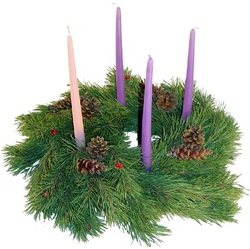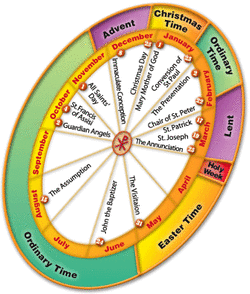Just a bit of a review for your test tomorrow:
Study:
- Notes on the liturgical year
- Holy days of obligation
- Advent notes (both pages)
- Memory verse
Luke Chapter 1 will not be on the test (even though it would have been open Bible). It will be on the Christmas Unit test in January (no open Bible).
Good luck!
Below is the prayer video from yesterday.
We completed all notes and charts on the liturgical year.
Please study for your quiz tomorrow.
Your test is on Thursday.
The video's message speaks for itself. Share this with your family!
Due Friday at midnight: How is this Advent going to be different for you than in years past?
Are you going to let the season slip away like previous years?

Today we recapped general information about the liturgical year in understanding that the primary purpose for the calendar is to remember and celebrate the main events surrounding Christ's life.
In one year's time, we celebrate Christ's birth, youth, public ministry, and Pascal Mystery ( remember: B, Y, PM, PM).
His Pascal Mystery includes his suffering, death, resurrection, and ascension.
We began a quick overview of the some of the seasons and the coordinating colors which are represented in the priest's dressing and the church decor.
Advent, the first season of the Church year, begins four Sundays prior to Christmas (be sure you know how to calculate when Advent starts). The season's purpose is to not only to prepare the for birth of the Lord, but to anticipate Christ's Second Coming. Advent is represented by the color purple, symbolizing royalty and expectation. Advent lasts for 4 weeks, ending on December 24th.
Christmas follows Advent, and the season begins on Christmas Day. The purpose of this 12 day season is to celebrate the birth of Christ, the Lord's Incarnation. Christmas is represented by the color white, and it lasts for 12 days, ending on January 6th on Three Kings Day (That's where the song, "The 12 Days of Christmas" comes from!).

Today, we began the Liturgical Year unit. Outside of the religious world, we all follow the regular calendar (January-December). But the Church has a special year, called the liturgical year, to mark the celebration of her liturgies and feast days. The liturgical year is built around important historical events—such as Jesus’ birth, death, and Resurrection—in which God’s saving power was made real. The liturgies in the liturgical year help us remember God’s
saving power made real in those historical events. They celebrate that God is saving us in the present moment, and they look forward to the time when God’s plan of salvation will reach its ultimate fulfillment in Christ’s Second Coming.
Today's classwork/ homework: Complete the liturgical year chart with colors (see the picture to the left) and complete page 272 in your workbook.


 RSS Feed
RSS Feed